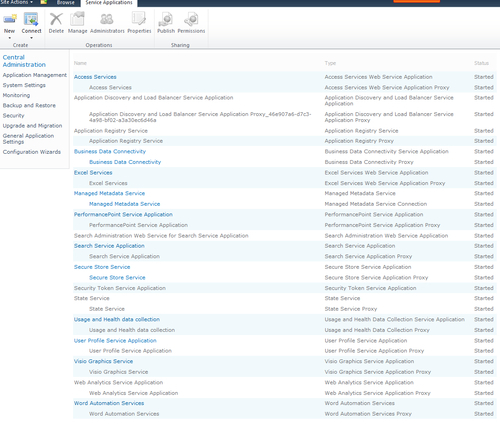In order to manage a service
application, the Farm Administrator or service application administrator
will either administer through the Central Administration website or
through PowerShell.
There is a Manage Service Applications
page that lists all the services running on the farm that you have
rights to manage. This will be clearly shown in the recipe you are about
to follow.
Many services have their own administration page and
in this recipe you will learn how to navigate to these and will be shown
the functional processes that you can do from the ribbon. For our
example, we are using the Managed Metadata Service.
Getting ready
You must have Farm Administrator privileges to the Central Administration website.
How to do it...
1. Open up the SharePoint 2010 Central Administration website.
2. Under the section titled Application Management, click on Manage service applications, which can be found under the Service Applications section. The following screenshot appears:

When navigating to this page for
the first time, the administrator can perform several operations from
the ribbon. You can create or edit an existing service application or
connect to another farm's service application.
The key is to pay attention to the ribbon at the
top and to the innate visual cues. Depending on what is clicked,
different ribbon components will light up. This is known as being
context sensitive.
3.
Navigate to a Service Application's administration page by clicking on
the service name. For instance, hover your cursor over the Managed Metadata Service, and it will be underlined as shown in the next screenshot:

When you click on the service application name, the respective management page is loaded.
4.
Another way to manage the components of the service is to click to the
right of the service application name. The entire line item becomes
highlighted in blue as seen here:

5. Observe the ribbon. All the features are now lit up as seen in the next screenshot:

Prior to this step, the only action we could perform
from the ribbon was to create a new service application or connect to a
service application that has been published.
Now we can:
Delete a service application.
Manage a service application. This brings us to the same page that step 4 brought us.
Assign Administrators to manage this service application. This is called delegation.
View and edit the Properties of the service application.
Publish the service application for another farm to be able to consume its services.
Assign Permissions to accounts that can access the service application.
How it works...
The Manage Service Application
page will show you all services you can manage in the farm and their
status. If you do not have the rights to manage a service application,
it will be security trimmed from your view.
The service application itself is listed first.
Underneath it, indented, is the service application proxy that connects a
consumer of this service from the web front-end to the service
application.
A service application may have one, more than one, or all of the following components:
Only the services that have been installed will be
listed on the page. Finally, the services that will be available depend
on the version of SharePoint that is installed.
There's more...
Shared services make use of Windows Communication Foundation (WCF).
As such, when the service applications are started, if you look in IIS,
there is an associated web service provisioned in the virtual directory
called SharePoint Shared Services. Expanding this directory you will see each service in the guise of a GUID. This GUID is not very helpful.
Right-click on a GUID, navigate to Manage Application, and then Advanced Settings. You will see the next screenshot:

As Physical Path, you can see the service that is associated with the GUID. You can also see that all services reside in the C:\Program Files\Microsoft Office Servers\14.0\WebServices\folder.
More info
Using PowerShell, you can obtain a listing of all the
farm service applications, their status, and their associated GUIDs.
Using PowerShell, the command is as follows: